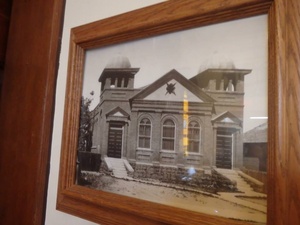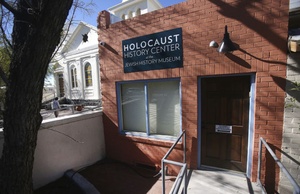The Tucson Jewish History Museum and Holocaust History Center is located in Tucson, Arizona and acts as a time capsule of sorts to maintain the rich history of the landmark first synagogue in the state of Arizona. The practicing temple, known as the Temple Emanu-El, has since changed locations to accommodate a larger congregation than it originally had upon its founding in 1910. The original temple has had some cosmetic refurbishing’s done over the course of time, but structurally it remains the same. Acting solely as an educational center, there is a lot to be gained by visiting the museum as it houses artifacts and information detailing the foundational period for this new community, as well as information on how local figures were involved in the Holocaust during the World War II era.
The Temple Emanu-El broke ground two years before the official recognition of Arizona’s statehood and thus it has truly managed to survive the test of time. Prior to the construction of the synagogue, the Jewish community began to grow and was practicing in Southern Arizona well before. As the congregation grew, it was deemed to be time to construct a central meeting place in which to conduct services. In the years leading up to its construction, the men of the community held smaller services in homes and various storefronts. The women of the community and members of the Hebrew Ladies Benevolent Society led the charge in making this dream a reality. With a rabbi from Texas serving as the catalyst for their movement by urging them to begin planning the new temple, the Hebrew Ladies Benevolent Society pushed for plans to be created by hosting events to fundraise to provide the Jewish community with a new home.
Though services had been held by members of the community, once ground was broken on the temple, it was time to have a new and recognized head of church. A Rabbi by the name of Martin Zielonka was called upon from the neighboring territory of New Mexico to lead the congregation.
Currently, visitors are able to visit this landmark during the week from Wednesday to Sunday to learn more about the growth of the Jewish community and its roots in Arizona. The museum offers a great opportunity for visitors to be up close and personal with various artifacts and writings detailing the formation of the first temple. The exhibits included in the museum cover a wide range of information that truly allow one to feel as though they have stepped back in time to experience Tucson as it was during the early 1900’s and even during the years prior to the verification of Arizona’s Jewish lineage. A collection of dated household items and even clothing from this time period help to detail how daily life may have appeared over one hundred years ago. In addition, a collection of original pieces from the synagogue are included such as minstrel garments, scriptures, and other items. The museum also receives many different displays and historically relevant items on loan from other museums across the state that patrons can view locally. With all of the different displays being showcased within the museum, perhaps the most impressive part of visiting this site was the architecture of the original building and the intricate and original stained-glass windows that still remain intact after over a century after their creation.
The Tucson Jewish Museum is limited in space as a result of the fact that the original structure has not been altered in terms of its square footage. On the temple’s grounds, their has been a new addition constructed that houses the Holocaust History Center which, although almost connected, comes across as a separate museum in its own right. Upon a first glance, one can easily tell that it is a newly constructed addition as it contains more modern elements than the neighboring Tucson Jewish Museum. The contents of this facility are, however, equally as rich and informative.
The Holocaust museum effectively provides exhibits, images, and videos to inform the public on the mass-genocide and persecution of Jews across Europe during the reign of Nazi Germany in the World War II era. The aspect of this museum that sets it apart is that much of the information and narrative provided is told through the scope of Holocaust survivors that would later on relocate to parts of Southern Arizona and join the bustling Jewish community that still exists and thrives today. The museum even details the family lineages of these survivors and shows how their arrival in Southern Arizona has laid roots that continue to grow today. While providing a more general background and overview of the Holocaust’s historical significance, the museum uses its displays to effectively bring more personalized attributes to light by linking the information to local survivors.
For those who recognize the Jewish faith, and even for those who do not, this is a great place to visit to become more knowledgeable on part of Southern Arizona’s local history.
COVID 19 Update
Unfortunately due to Covid -19 The Tucson Jewish history museum and Holocaust history center has been closed for a year now. This means no one can come into the building therefor many people have not been able to educate themselves. The organization has put many online exhibitions so people are still able to grow their knowledge in a safe environment. These online exhibitions share everything everyone needs to know about Jews in southern Arizona and how they got there.
ONLINE EXIBIT SUMMARY
The exhibit talks about how the Jewish people got to Tucson and the major role they played in creating what Tucson is today. The Santa Cruz River plays a big role in how people got to southern arizona. The people known as Akimel (River People) and Tohono O’odham (desert people) have been here for more than 5,000 years. These were the first people to ever come to South Arizona. They were able to make strong connections to the mountains and cactus so they never wanted to leave this area. The area that they loved so much is now known as Tucson Arizona . They had a challenging life here dealing with labor work, slavory and compulsory education in the 17th century. Somehow they were able to get through it all. In 1684 the first jews arrived in the American Colonies. These people came from brazil then New amsterdam to modern day manhattan where they spread throughout the united states. 200 years later Ashkenazi Jewish came to southern Arizona to start their lives. Most of these people came for an Economic Opportunity to start their new lives and to be happier. At this time southern Arizona was just mountains and cactuses. These Ashkenazi Jewishs came together and built their own towns. In 1880, Jacob Issacson played a major role by building a trading post along the Arizona-Mexico Border. This helped the economy in many ways as well as helping make connections with other people. There were many Jewish families who helped develop many economic opportunities in the city. This town was called “douglas” and Jewish families played a huge role in creating this town. In the city “Douglas” many Jewish families took the opportunity to create their own family businesses. The First ever Arizona Jewish Congregation formed in 1880 in Tucson, Arizona. A family of brothers formed this congregation by asking many individuals around Arizona to join them. The first ever service was located in the Hall at Levins park. It's so important for Jewish people to pray together so this was a very big turning point for this Jewish community. Many Jewish families took leadership roles throughout the city of Tucson. In 1883 Charles Strauss was elected to be the first Jewish Mayor of Tucson. With Charles and Mansfeld help they were able to establish the University of Arizona. Without these men the University Of Arizona would not be in Tucson today.Tucson would be a very different type of city if the University of Arizona was not here. Then in 1904 the Sisterhood of Temple Emanu EL formed. This allowed many women to stay connected with their friends and raise money for people in need. In 1910 they were able to build the first synagogue in Arizona.This took many years of raising money but with hard work they were able to get the funding. Shortly after the first synagogue the first Jewish Cemetery was created. The Rabbi of Temple Emanu EL, Rabbi Gumbiner left a huge impact on the Tucson Jewish community and was involved in civil rights all around Arizona. He helped southern Arizona be a peaceful place for everyone. In the second half of the 20th century the population of jewish in Tucson grew rapidly. In 2008 after Temple Emanu El was vacated for many years, The Jewish people decided to turn it into the Jewish History Museum 564 Stone Ave, Tucson Arizona. Tucson has been able to be such an important city for many years now. People come here to learn all about how jewish people impacted Tucson on what it is today. Without this museum there wouldn't be a place for people to learn how the Jewish people got there.
JEW IN TUCSON
Tucson It's a great community with many friendly people from all over. The Jewish people really did help mold Tucson to be a great place for many people. It's important to the community to realize how Tucson really started. The story of Tucson building a community very fast is inspiring and powerful. This story really shows if people put their mind to something and bring others into help them they will be able to grow something really amazing. Tucson residents should all take the time to go to the Jewish History Museum. Even if someone is not Jewish the Museum talks about the connections the Jewish people made throughout their time here. It's inspiring to see the growth that Tucson was able to make. The Tucson Jewish Community still exists here today. Tucson JCC allows Jews to hang out together and get involved in many activities. The JCC has everything from Fitness memberships to Art gallery to ECCS which helps people stay connected to one another. Along with the JCC Tucson has The Jewish Federation Of Southern Arizona. This organizes fundraisers and even trips to israel. On the U of A campus they have Hillel which welcomes Jewish kids as a second home for shabbat or a place to study. The Hillel building lets students meet one another on campus. These jewish families who came to southern Arizona and used there leadership skills really helped Arizona be what it is today.
References
http://www.jmaw.org/temple-emanuel-tucson-synagogue/
https://www.jewishhistorymuseum.org/holocaust-history-museum/
https://www.jewishtucson.org/community-agencies/jewish-history-museum-2/









